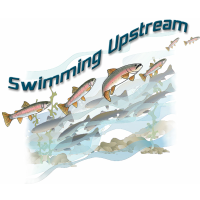Massive Fish-Lift Trucks Drought-Constrained Salmon to the Bay

It’s one thing to bid a fond adieu to the beloved Delta smelt, long on the environmental death watch, jeopardized by the drought and standing in the way of Governor Jerry Brown’s giant water tunnels. You don’t find them on restaurant menus or grocery aisles.
Salmon is another story. California’s Department of Fish and Wildlife (DFW) is directing a massive effort to truck tankloads of baby salmon from fisheries to the San Francisco Bay to help save the fishing industry, keep the species alive and put a Band-Aid on the food chain.
Ellen Knickmeyer at Associated Press said it was the first time all five government hatcheries in the Central Valley were pressed into service. They’ve been hauling fish since March.
State and federal wildlife agencies told AP it was the largest fish-lift ever. 30 million salmon. But that’s the same number announced in last year’s monster effort of 22 truck caravans. The state regularly does this sort of thing, but on a smaller scale. The drought has engaged the federal government the last two years.
In a wetter, more hospitable world, the young fish released from hatcheries swim via rivers to the ocean and spend some time maturing before returning home to spawn. They would become part of a homecoming population in three years.
But four years of drought has made that impossible. Last year, 95% of the Chinook salmon population disappeared. The rivers are too warm and too shallow. The melting snowpack in the Sierra Nevadas that used to feed the chilled rivers and streams is mostly gone. It’s estimated that a couple centuries ago 2 million Chinook spawned in the Central Valley.
Robert Lackey, a professor of fisheries at Oregon State University, Corvallis, told Yale Environment 360 that huge runs of salmon in California will have disappeared by the end of the century. A study published in the journal Nature said climate change would wipe out the West Coast’s Chinook stocks because they don’t adapt well to warming water. Juveniles tend to develop heart problems.
Just a few spring-fed rivers are expected to be cool enough to support spawning. But the fish will continue to thrive in more northern Pacific regions, like Alaska and Russia, Lackey said.
That’s a good thing, because not everyone thinks fisheries are the answer to the California salmon problem. Peter Moyle, a fisheries biologist at the University of California, Davis, told Yale Environment 360 that inbreeding and diminishment of natural selection are taking a toll on the salmon genome. Eventually they will be too stupid to avoid predators, locate food or find their way home.
Some scientists dream of reconnecting drained wetlands in the Central Valley, restoring water flow and regulating dams in a way that facilitates the flow of cold water to spawning grounds. That’s not going to happen now and probably wasn’t going to happen before the drought.
–Ken Broder
To Learn More:
For California Salmon, Summer of Truck Rides, Bucket Lifts (by Ellen Knickmeyer, Associated Press)
For California Salmon, Drought and Warm Water Mean Trouble (by Alastair Bland, Environment 360)
Chinook Salmon in Danger of Being Wiped Out (by Karen Graham, Digital Journal)
30 Million Drought-Stricken Salmon Being Trucked to the Ocean (by Ken Broder, AllGov California)
- Top Stories
- Controversies
- Where is the Money Going?
- California and the Nation
- Appointments and Resignations
- Unusual News
- Latest News
- California Forbids U.S. Immigration Agents from Pretending to be Police
- California Lawmakers Urged to Strip “Self-Dealing” Tax Board of Its Duties
- Big Oil’s Grip on California
- Santa Cruz Police See Homeland Security Betrayal in Use of Gang Roundup as Cover for Immigration Raid
- Oil Companies Face Deadline to Stop Polluting California Groundwater





